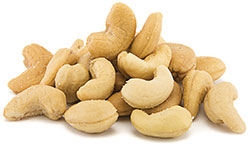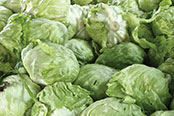Modifying nut proteins to remove allergens; New cooling technology for produce
CUTTING EDGE TECHNOLOGY
 Restructuring proteins may remove allergens in nuts
Restructuring proteins may remove allergens in nuts
For the millions of adults and children who have to avoid nuts due to an allergic reaction, help may be on the way thanks to U.S. Dept. of Agriculture (USDA) researchers. Scientists led by Research Molecular Biologist Chris Mattison, Ph.D., at the Agriculture Research Service (ARS) branch of USDA in New Orleans, LA, are developing a method to process cashews—and potentially other nuts—that could make them safer to eat for people who are allergic to them.
Mattison’s team is looking at ways to modify proteins in tree nuts and peanuts (legumes) that trigger an immune response in people who are allergic. The response is caused by antibodies called immunoglobulin E (IgE), which recognize and latch onto the proteins. Changing the shape of the proteins makes it harder for IgE to find them, notes Mattison.
But past research taking this approach has involved chemicals. Mattison wanted to see if his team could achieve the same results, but using compounds that are generally regarded as safe or GRAS. “We found that the GRAS compound sodium sulfite can effectively disrupt the structure of a couple of the cashew allergens,” Mattison says. “And we’ve done a couple of different tests to show we reduced IgE binding to the proteins when they’ve been treated with sodium sulfite.”
Next, they plan to conduct experiments on whole nuts and test the modified proteins on cells in the lab to see how they respond. They’re also looking at enzymes, which are molecules that can cut up proteins, as candidates to disrupt the allergens. Although this research focuses on cashew proteins, Mattison says the work could have broader implications. The kinds of allergenic proteins the GRAS compound and enzymes affect are not exclusive to one kind of nut. “One of our goals is to apply our knowledge from the cashew experiments to other tree nuts and to peanuts,” he says.
 Uniform cooling extends produce shelf life
Uniform cooling extends produce shelf life
A new cooling technology called Permachill from TOP bv, Wageningen, Netherlands, uses the walls of the room as refrigerants to provide uniform cooling and achieve an optimum temperature of just above 0° Celsius everywhere in the refrigerated area. This extends the quality of fresh produce and results in less waste compared to conventional techniques that cool products at a temperature of 4–7 °C through air cooling. The airflow causes temperature fluctuations that may result in freezing damage to delicate product.
The new technique can be applied to refrigerated storage and refrigerated transport. Each link in the supply chain can benefit from a longer shelf life of fresh produce. In addition, the system consumes less energy than conventional cooling methods, which contributes to the sustainability of the chain. “Individually, the various stakeholders in the fruit and vegetables chain are becoming more efficient and professional,” said TOP Director Wouter de Heij. “But there is still much to be gained in a chain-wide approach. By continuous stable cooling throughout the chain the product shelf life can be extended significantly.”
An accompanying online calculation method (web app) on the Permachill website (www.permachill.eu) calculates the potential shelf life gains that can be achieved by using Permachill refrigeration on fruit and vegetables. For example, the shelf life of lettuce can be extended three days.
If you are working on or know of some cutting edge technology that you would like to be featured in this column, please send an email to [email protected].
